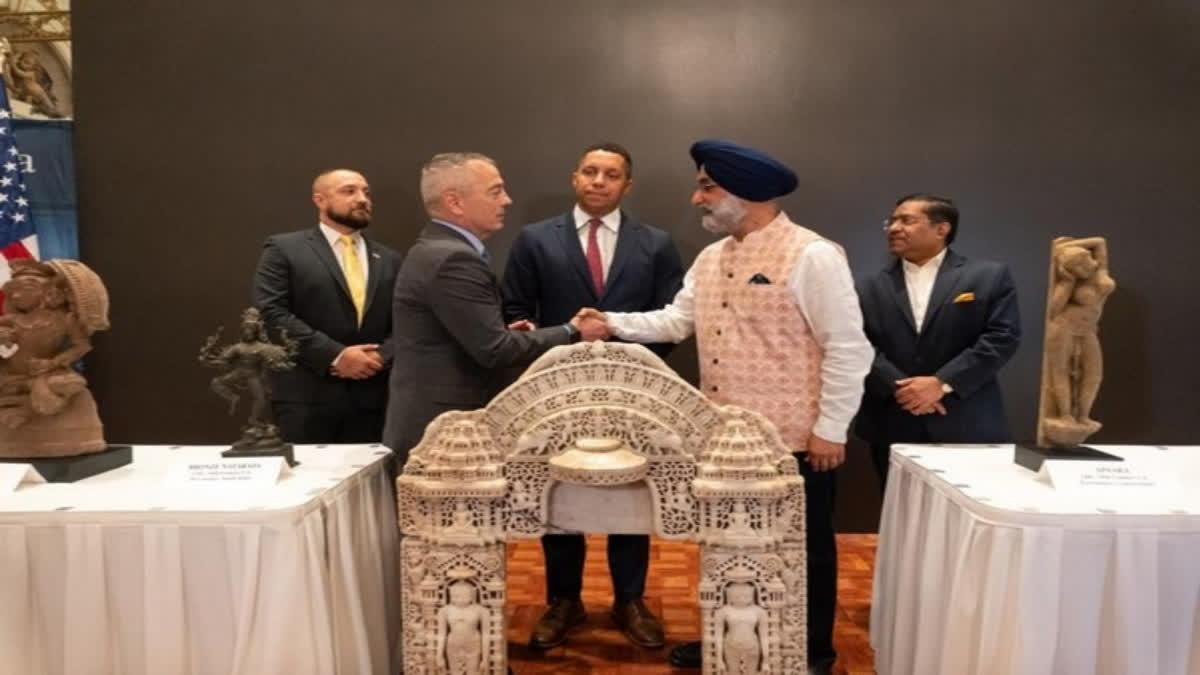New York: Over 60 ancient artefacts highlighting early Buddhist art have been brought from India and will be on display at the prestigious Metropolitan Museum of Art (Met) here for a special exhibition marking 75 years of the country's independence. The exhibition, titled 'Tree & Serpent: Early Buddhist Art in India, 200 BCE400 CE', is a collaborative project between the Indian Government and the Met.
More than 140 objects depicting the story of the origins of Buddhist art dating from 200 BCE to 400 CE are on display in the exhibition. Of these, about 62 pieces have come from India for the exhibition, which celebrates 75 years of the country's Independence, 'Azadi Ka Amrit Mahotsav.'
The exhibition, inaugurated by India's Ambassador to the US, Taranjit Singh Sandhu, on July 17, opens for the public on July 21 and will run through November 13. The leading lenders from the Indian side are the Archaeological Survey of India, the National Museum of Delhi, the Government of Telangana, the Government of Andhra Pradesh (Amravati Museum), the Government of Maharashtra (Kolhapur Museum) and the Government of Bihar (Bihar Museum).
Other pieces in the exhibit have been loaned to The Met by museums in Italy, Germany and UK. In his remarks at the exhibition's opening, Sandhu said that it is special for many reasons, but none more meaningful than the occasion it marks: 75 years of India's independence. He said that although India as a modern nation might be 75 years old, it is an ancient civilisation whose past flows seamlessly into the present. He added, "This celebration of our ancient heritage is very thoughtful."
Sandhu said Buddhism has been amongst the greatest gifts from India to the world. "More than 2500 years ago, Buddhism originated in India. Today it is practised in more than 100 countries. It is such a strong unifying factor," he said. Sandhu noted that last month during Prime Minister Narendra Modi's historic state visit to the United States, the Indian leader and US President Joe Biden announced new dimensions of bilateral knowledge engagement, green partnership, innovation and space collaboration, and commitment to foster closer cultural ties.
"In many ways, each of these themes finds expression in Buddhist art," Sandhu said. He added that India has been deeply influenced by Buddhist philosophy and has been working with like-minded partners, including the US, to address diverse world headwinds.
"This is manifested in many ways as one of the first responders during disasters, or as an exporter of vaccines to more than 100 countries to fight the COVID-19 pandemic, or by driving sustainability through Mission LiFE, promotion of Yoga or the unifying spirit in the theme of India's G20 Presidency Vasudhaiva Kutumbakam one earth, one family, one future," Sandhu said.
He noted that under Prime Minister Modi's leadership, the Government of India is keen to strengthen people-to-people linkages weaved through a common thread of Buddhism. Initiatives like the development of the Buddha Circuit in India and Nepal, the rejuvenation of pilgrimage centres like Sarnath and Kushinagar, and assistance to several countries in India's neighbourhood and Southeast Asia for the construction and renovation of Buddhist monasteries are a few examples of New Delhi's efforts.
Sandhu expressed confidence that the art exhibition will add further meaning to building a closer understanding between the two countries and their people. Prominent guests from India who attended the opening of the exhibition included National Museum Director General Dr BR Mani, Archaeological Survey of India Director General Prof KK Basa, Bihar Museum, Patna Director Anjani Kumar Singh, Principal Secretary, Government of Telangana Sandeep Sultania and Special Secretary to the Chief Minister of Andhra Pradesh Dr M Harikrishna.
From the Indian side, the Ministry of Culture and the National Museum are the lead coordinators of the exhibition. Some of the exhibition's highlights are the Indian ivory Yakshini from Pompeii, Italy, displayed alongside the Roman period bronze Poseidon excavated in Maharashtra.
The Yakshini was found in the ruins of Pompeii after the city was destroyed by the volcanic eruption of 79 AD. Kolhapur Museum has loaned the Poseidon. The two objects attest to the flourishing connection between ancient India and ancient Rome. The Poseidon is among the 37 bronze and copper objects excavated in 1945 at Brahmapuri in Kolhapur in western India.
"The cosmopolitan mix of indigenous Indian objects and Roman imports suggests a merchant's inventory of goods destined for sale in the Satavahana territories of the Deccan," the Met said. Other highlights of the exhibition are the several artefacts from Phanigiri in Telangana. This site is among the latest excavations that have revealed a large Buddhist stupa with associated buildings.
The exhibition also includes several artefacts from the Bharhut Great Stupa, Madhya Pradesh, including railing coping, railing coping fragment with lotus bloom meander, railing pillar with Naga Mucalinda protecting the buddhapada that depicts the moment when the Snake King (Nagaraja) Mucalinda sheltered the Buddha, who was in deep meditation in the sixth week after his awakening.
A railing pillar medallion: veneration of the Dharma-wheel (dharmacakra) and railing pillar medallion: tree shrine marking Konagamana Buddha's awakening in which a pair of female devotees kneel before a throne that marks the spot where the Buddha Konagamanaone of six past Buddhas (the historical Buddha of the present age is the seventh)attained awakening, are also displayed in the exhibition. (PTI)



